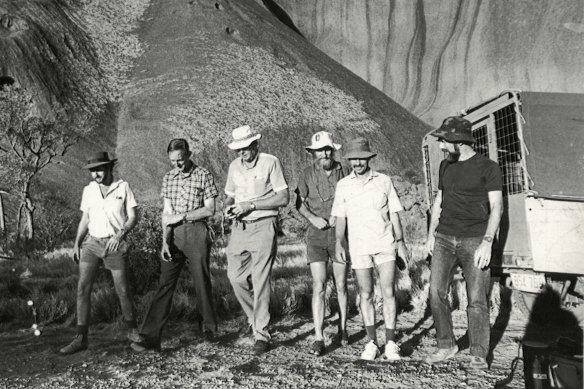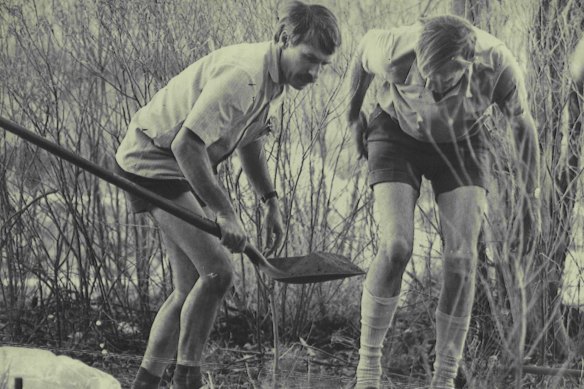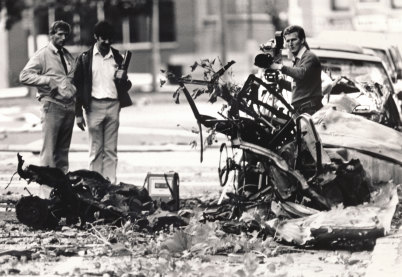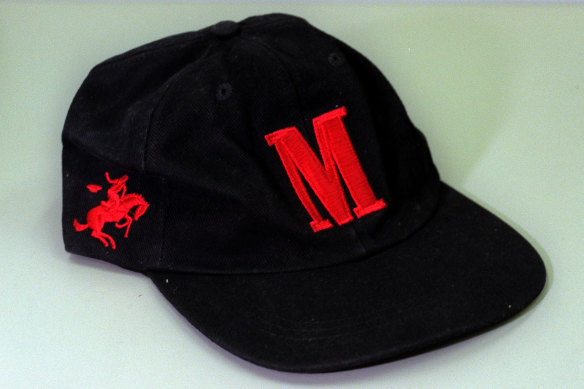- Analysis
- National
- Victoria
- Naked City
This was published 3 years ago
How boffins put the cap on a murderer
A good cop knows how to dig up the dirt, but few did it better than Henry Huggins, one of the first to grasp that forensic evidence could be the jewel in any prosecution crown.
For years, while the cameras concentrated on stern-faced detectives in dark suits and porkpie hats, in the background a man in a grey dustcoat carrying his battered murder bag would be ferreting for clues.

Henry Huggins (second from left) at the Azaria Chamberlain site near Uluru in February 1986.Credit: Age archive
We lost Henry, aged 90, in February and with him the last link to a time when you learned largely on the road. He joined in 1959 and soon found himself in the Scientific Section, driving a former army Studebaker canteen van refitted as a mobile lab to some of Victoria’s biggest crime scenes.
His son, Daniel, remembers family dinners when the phone rang and dad was gone, meal left untouched on the table.
Victoria Police historian and former inspector Ralph Stavely says Huggins was “extremely intelligent, patient and hugely thorough”.
Before computers simplified the most difficult forensic problems, Huggins used his trained eye and skilled hands to crack the case of the cracked skull.
A man was found dead with fatal head wounds. A shattered vase was found nearby. Piece by broken piece Huggins reconstructed the vase and found fingerprints on the neck that showed the offender used it as a weapon to bludgeon his victim. As well as the prints, Huggins found a button from the offender’s shirt at the crime scene.

Henry Huggins (right) at the Azaria Chamberlain crime scene.Credit: Age archive
So respected was Huggins that he was called in to lead the 1986 crime scene examination when baby Azaria Chamberlain went missing near Uluru.
In retirement, he couldn’t bear to watch Hollywood-style forensic procedural shows as he would solve the crime before the first ad break.
As a tribute to Henry and all the backroom experts, here are our top 10 contributions by the boffins.
1) Colin Campbell Ross was hanged in 1922, an innocent man, after he was wrongly convicted of killing 12-year-old Alma Tirtschke. The key evidence was hairs found on a mattress at Ross’ home, declared to be from the victim.
In 1995, researcher Kevin Morgan traced the exhibit to an archive and pushed for the hair to be re-examined using modern technology.
In 1998, a test by the Victorian Institute of Forensic Medicine found they were not from the victim’s scalp and Ross was posthumously pardoned.
2) In September 1992, a man abducted a couple near the National Gallery. When chased by security guards the offender turned and fired, hitting one of the guards on the hip. He was arrested at the scene.
A ballistics expert saw similarities between the sawn-off rifle used and an unsolved triple murder in Burwood several months earlier. He took the gun to the Forensic Science Laboratory, test-fired it and proved it was the murder weapon. Ashley Mervyn Coulston was charged and convicted of the triple murder.
3) In 1990, Robert Tuddenham, 65, had been missing for six days from his home in the tiny Mallee town of Lascelles and police were convinced he had been murdered.
A sergeant from Search and Rescue was driving down a deserted road when he spotted a tiny piece of material stuck on the top barb of the fence. He stopped and saw it was a small piece of a rug. It was enough for him to call in the police helicopter and from the air it spotted a darkened piece of recently disturbed sand and fresh footprints.
It was where two killers had buried Tuddenham, wrapped in a rug taken from his house. The rip in the rug matched the piece on the fence.
4) On March 27, 1986, a gang detonated a bomb of 60 sticks of gelignite in a stolen Commodore parked outside the Russell Street police station, killing Constable Angela Taylor and injuring 21 people.
Slowly experts rebuilt the bomb car - a massive task considering the size of the explosion, with debris found on the roof of the Queen Victoria Hospital, three blocks away.

The car bomb that ripped through the police headquarters in Russell Street on March 27, 1986.
Eventually Stolen Car Squad sergeant Arthur Adams realised that the bomb car and a second stolen car, used in a Donvale bank raid the same day, had chassis numbers removed by a method favoured by car thief Peter Reed.
Reed was nominated as a person of interest within days of the bombing as he had a deep hatred for detectives from the Stolen Car Squad who worked at Russell Street.
During a raid to arrest Reed he fired on police, shooting Mark Wylie. He was also shot by police. Further tests showed the redgum block used to secure the bomb came from the fence of one of the bombers.
5) In March 1985, Raymond Edmunds was arrested for indecent exposure in Albury, NSW, and fingerprinted. If he had committed the offence about 100 metres away, in Wodonga, he wouldn’t have been printed, because it was not mandatory in Victoria at the time. The prints were instantly recognised by a police expert as a match to the Shepparton murder scene of Garry Heywood and Abina Madill from 1966 and a later rape in Melbourne.
6) It looked for all the world a murder. The man was found with a fatal gunshot wound to the head, with the gun several metres away. Henry Huggins decided to test bite marks on the rifle stock, matching them to the dead man’s dog, “Macca” - leading to the conclusion that the loyal German Shepherd dragged the gun away to try and protect his owner. The Coroner concluded it was suicide.
7) The 1986 bombing of the Turkish consulate in Melbourne was one of those crimes where an offender’s ambitions exceeded his ability, as he was blown up in the attack. Experts found a tiny piece of skin, the size of a five-cent piece, at the blast site. It was found to match a print on an invoice book from a Sydney suspect. The only other remains found was a pair of feet still sitting in the bomber’s shoes.
8) It was a crime that would not have been reported if two Glen Waverley neighbours hadn’t seen the young man being bundled into the boot of a car in the middle of the day in the middle of the week.
When police arrived, there was no obvious motive and only one obvious clue: a black baseball cap emblazoned with a red M.

The black cap found at the crime scene.Credit: Victoria Police
It was one of 150,000 promotional caps given away in duty-free outlets in the United States to buyers of cartons of Marlboro cigarettes.
One buyer grabbed four cartons from the Tom Bradley Terminal at Los Angeles Airport at 12.46am on April 20, 1996, and produced his Cathay Pacific boarding pass for a flight to Hong Kong as proof he was a legitimate traveller.
From there he flew to Sydney and to Melbourne with his brother. They were here to abduct Le Anh Tuan, 21, because an international crime gang believed his parents owed $400,000.
The abduction was ordered out of London, using US hitmen on behalf of a Hong Kong-based syndicate. Once police became involved, the ransom plan was shelved and Le drugged and shot dead.
Once Victoria Police had connected the Marlboro cap to the brothers, Los Angeles detectives grabbed one from Long Beach City College to interview over bogus local charges. The man was nervous and asked if he could smoke. One cop said he could, as long as he spat on the butt to make sure it was dead. The butt proved a DNA match to the black cap.
When the second brother was charged with heroin trafficking and was facing likely execution in a Vietnamese jail, Victorian detectives flew to the jail, and after a lunch of pond fish, dog meat, rice and jail-made brandy, offered him a deal to turn on the boss in exchange for a short sentence in Australia.
The brother declined because, he said, the syndicate would kill his family. He was executed by machine gun.
9) Drug boss Tony Mokbel had been on the run for more than a year after jumping bail during his cocaine trafficking trial and police had no idea he had bought a yacht and sailed to the other side of the world to settle in Greece.
That is until, in May 2007, he rang a mate in Melbourne on a phone monitored by the police. “Hey, Buddy, what’s happening?” he asked, saying he was at Starbucks at the Glyfada Piazza.

The Edwena, bought as part of old sea dog Tony Mokbel’s daring escape plan.Credit: Victoria Police
Sitting in the Purana Taskforce office was Jim Coghlan, who had married into a Greek family and knew instantly that Mokbel was hiding in an Athens suburb. It led to Mokbel’s arrest and extradition.
10) Serial killer Paul Charles Denyer thought he had all the answers sitting in the Frankston police station being interviewed about the 1993 murders of three women. At the same time pathologists conducting an autopsy on his last victim found a piece of foreign skin that must have been from the killer.
His interviewer, Detective Senior Sergeant Rod Wilson, had seen the fresh wound on Denyer’s hand and waited more than 1000 questions to confront him. For the first time Wilson called Denyer out as a liar. It was the moment the killer knew he was trapped and decided to confess.